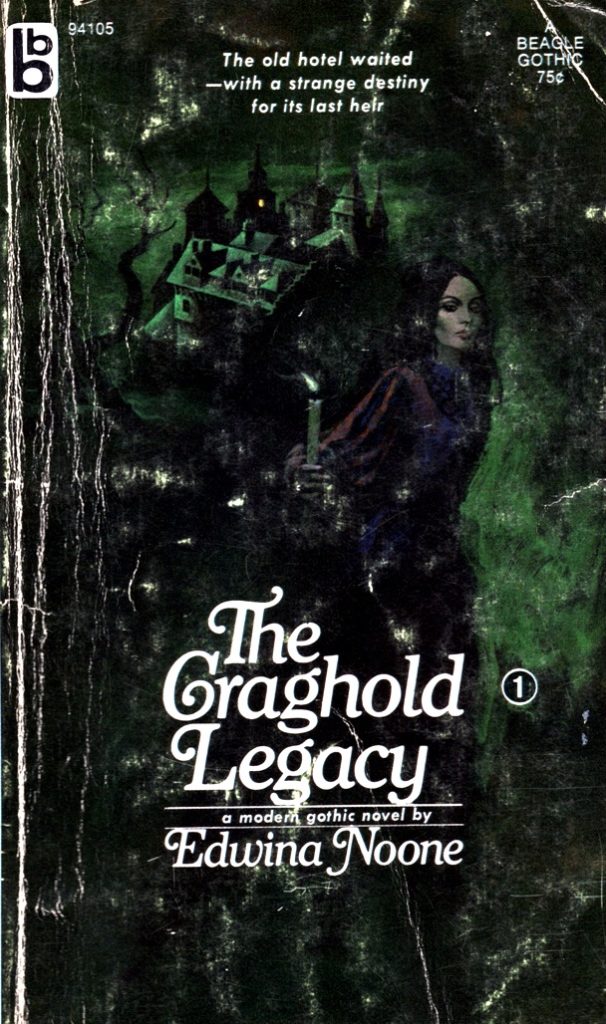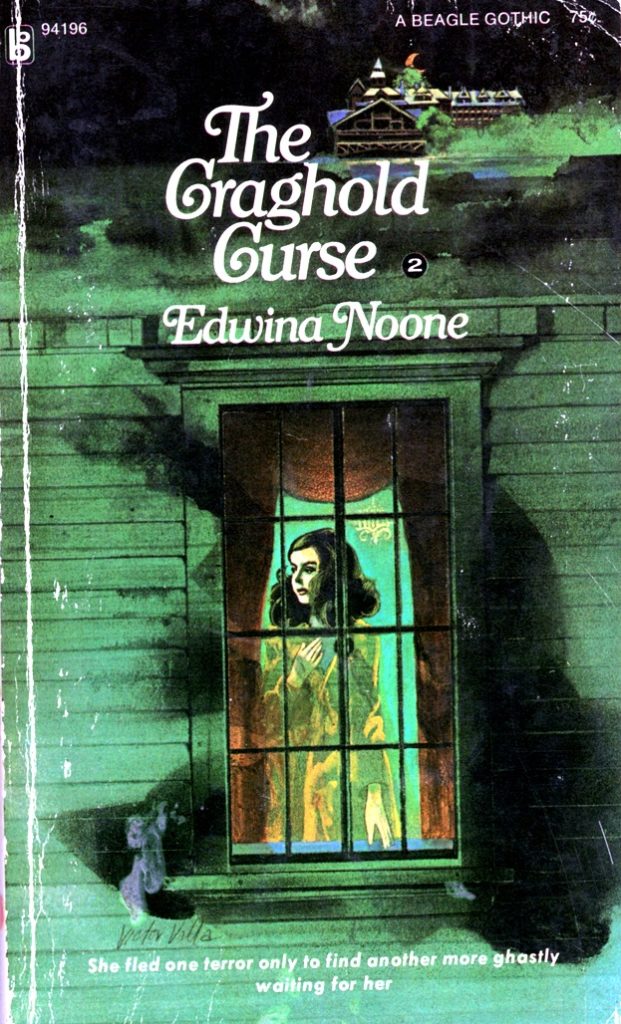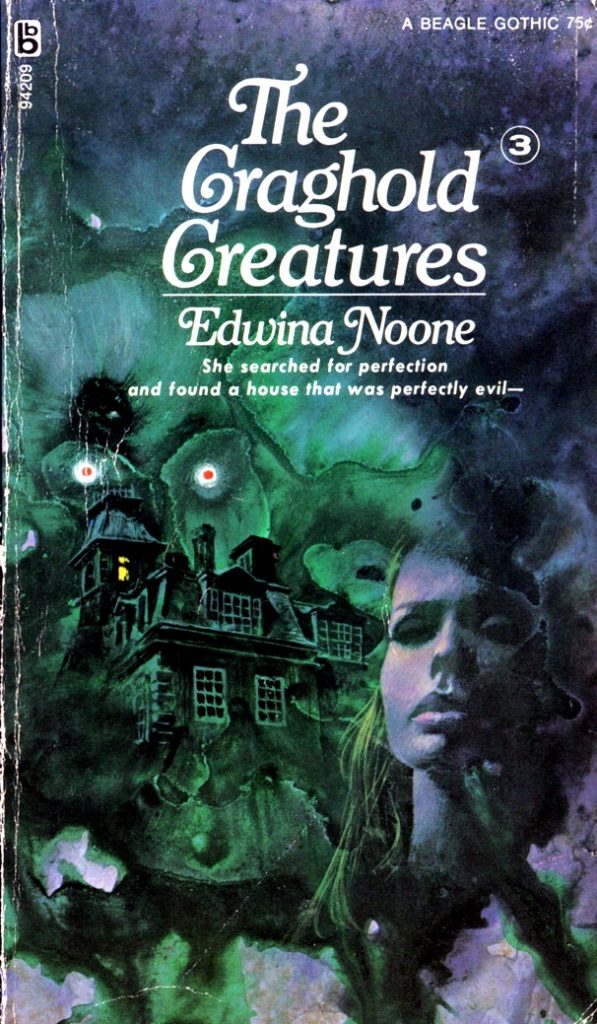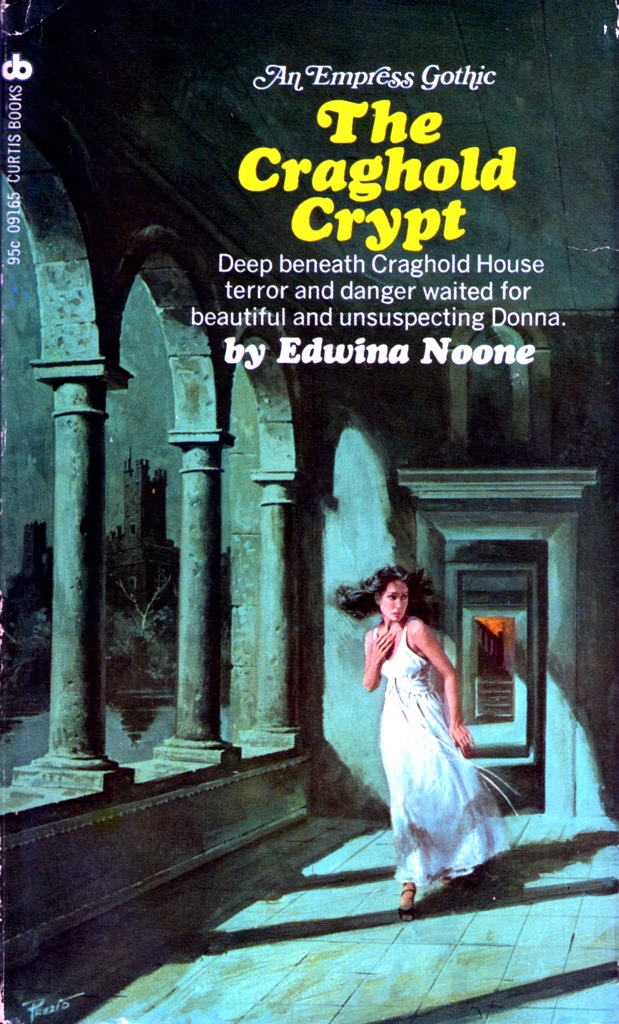
The Craghold quartet is highlighted primarily by its first volume, The Craghold Legacy, which delivers an unwavering deluge of bizarre. Undeterred by the novella format, Edwina Noone (aka Michael Avallone) manages to incorporate every Gothic item imaginable in a single narrative. Somehow, miraculously, he succeeds. The follow-up entries are less mesmerizing because the world is already so richly established. Lacking initiative to expand its potential is disappointing, and yet there is also a familiar pleasure with having the same events reoccur over changed seasons, and with fresh victims at the mercy of the same haunted hotel.
Connections between the four books are minimal at best. They can be read in any order without missing critical information. The series should begin with the first, however, only to best lose one’s virginity to all the uncanny characters and otherworldly happenings. Here are my reviews of each individual novel:
01. The Craghold Legacy
My first venture into the gothic romance novels of the 1960’s and ’70s. Otherwise known as “women running from houses” books because every cover, regardless of author or publisher, featured an upscale woman fleeing a spooky building. Rumor has it, publishers demanded the eerie structures be painted thick and tall to imply phallic imagery.
Like any fad genre, I’m sure many books fitting this mold are terrible. As for Craghold, however, I’m hooked! It has every gothic thing imaginable, sometimes all on one page – haunted hotel, supernatural moon glow, ghosts, sexy occultists, wealthy heirs, devil worshippers, spooky room service, and a hotel manager who’s also a scholar on werewolves and vampires. I’m sure I’m forgetting something.
Oh yeah! There’s a bit where the smoldering man sings “Take me out to the hex caves” to the tune of “take me out to the ball game.” How can it get any better than that?
Truly it is awe-inspiring how much adventure is packed into a slim 150 pages. Even more miraculous, it doesn’t feel rushed. Time is allotted to graciously describe hotel décor, or the immaculate beauty of every character. Internal thoughts are frequent, unabridged, and desired. When the frights rise to a climax, we’re given sufficient time to relish the drawn-out moments of peak terror. I’ve read 500 page books without this much adventure, and with weaker characters.
Given the resurgence of horror novels from the ’80s, I hope these earlier creepers find a way back into the hearts of breathless readers. The full Craghold series seems nearly impossible to find online, or at least not for cheap. Libraries don’t carry them. Either there’s a lot of people holding on to books nearly 60 years old, or soon enough they’ll be gone forever.
If you can find a copy of The Craghold Legacy, I highly recommend it. Otherwise, any old ‘woman running from houses’ title might be better than you think. If you find one, please review it because I’m looking to read a whole lot more of these!
**UPDATE: Since this review was originally posted, The Craghold Legacy has been reprinted as an eBook. Unfortunately the other books in the series remain difficult to track down.

2. The Craghold Curse
Winter has come to Craghold House, the secluded hotel managed by a Satanist and populated with a variety of ghosts and other gothic entities. Avalanches of fluffy snow dazzle landmarks, such as the Hex Caves and Goblin Wood, but treacherous conditions do little to prevent more calamity for the unfortunate guests.
This second book in the series makes no references to the prior adventures from The Craghold Legacy, except that we get to see the mysterious staff continue to act in character and experience more frightening shenanigans, both earthly and otherworldly.
Our leading lady this time is yet another timid beauty. Her male interest is a charming author studying the hex caves for the purpose of writing an archaeology book, or so he says. More interestingly, she seems to have some amount of daddy issues as evidenced by her continual references to the attractiveness of her bulldozing, militant father. To be fair, there are no unattractive people at Craghold House. Even the satanic manager is depicted as a gaunt, Nosferatu-esque hunk.
Overall, it’s not as good as the first book, though they are essentially the same. The characters have less flair and the mysterious occurrences are less captivating. Still, a solid delivery. These old gothic romances have unearthed something in me. I’m kinda obsessed. Perhaps all I need from a book is eerie atmosphere, spooky occurrences, and sexy people. And that’s exactly what this has to offer.

3. The Craghold Creatures
A beautiful woman arrives at the haunted hotel, her bags are mysteriously relocated by a phantom bellhop, and horrors occur. Of the three Craghold books I’ve read so far, this one is the most disorganized and probably my least favorite. But it does amp up the horror elements significantly and adds minor developments to the world of Craghold House.
The premise for the female’s arrival is good. She is a powerful force in the movie industry and scouting locations to film an adaptation of a popular horror novel. Naturally Craghold House is the perfect setting. Even after witnessing beasties and nearly being killed, she feels compelled to establish locations for the movie. It’s a decent reason for keeping the cast confined within the hotel’s haunted walls and a social dynamic more interesting than the leading ladies of the previous two books.
Another perk of Craghold Creatures is more reveal of the satanic undercurrent that lurks within the Hex Caves and Goblin Wood. The devil worshipers get much more face time in here, which is always fun, even if most of it is quite laughable. This book also comes closest to being dirty, with our heroine going so far as having a naughty dream about the dashing young man of her affection. Scandalous! These books were written in an era pre-bodice ripper, however, so don’t expect much on that front.
Again, the adventures of the previous two books go unreferenced here. Maybe the fourth book, which is twice the length of the others, will tie up some loose ends. Probably not, but oh well. I’m still having a great time going through this series even though it’s a long way from great literature.

4. The Craghold Crypt
And thus concludes this gothic quartet of haunted hotel novels. It’s been a twisted, incredibly formulaic ride of ghostly bellhops, vampiric caretakers, satanic ritual, and smoldering young men flirting with attractive virgins. Each book has its highs and lows, though I can’t say they are ever boring. In retrospect, that’s an unusually impressive accomplishment. All four books carry a near-identical plot, and yet it’s a breeze to devour all 750 pages of their combined length. How is that possible?
The writer in me is curious. These four books do not just follow a similar structure, they are practically word-for-word recreations of each other. The progression of danger is always the same. The gist of character development is line-for-line. Every time. And yet–still—I’m on the edge of my seat! I can’t say that this miracle is attributed purely to good writing, though on average the writing is very good, but perhaps it is a testament to the power of gothic storytelling.
Like the protagonist in Northanger Abbey, I simply can’t get enough spooky. It doesn’t matter that the characters are paper thin or the premise hackneyed. All I need are those lengthy descriptions of eerie exteriors, foreboding corridors, haunting figures, and the promise of dread around every corner. Nowhere in the series do we get more of that than here, in The Craghold Crypt. It’s twice the length of the other books, but don’t mistake that detail to mean there’s more action. The added girth is solely attributed to pages and pages and pages of description like this:
Her first impulse was of deep revulsion, a desire to turn and go away, anyplace but here. The stillness of the atmosphere, even though the driver had kept his motor running, was funereal. She was unable to hear so much as a bird, much less a cricket stirring in the thickets. Oddly, there was no smell of greenness or budding plant life, as there should have been. Only the supernatural coldness or coolness that swept across the open earth like an Arctic chill. And still not so much as a tiny light, candle or electric, gleamed from the darkened windows of the structure. If it was a hotel, they certainly did not know how to make their guests feel welcome! The hotel was a morgue!
It goes on. It always goes on. Occasionally I would think the descriptions go on too long, and of course they do, but then I’d also realize I’d just read 20 pages in the blink of an eye. No skimming either. To write a gothic is to be aware of what makes the genre so addicting. It has very little to do with good storytelling, I think, and significantly more to do with being spooky. Gothic readers need atmosphere like cocaine addicts need a bump.
My final thoughts on the Craghold series is that it’s hardly a life-changing set of books, and yet they have changed my life. Mostly because they took my mass market-gothic virginity. I’ve read classic gothics like Frankenstein and Jane Eyre, but those novels are fully-realized masterpieces. The mass market gothic exploits the genre, strips it down to the bare essentials. It’s a minor experience comparatively, but the raw, unfiltered joy of it is there. Like having dessert for dinner. I’m not proud to say I love these books, but, oh yes, I do.
Join us on social media…
